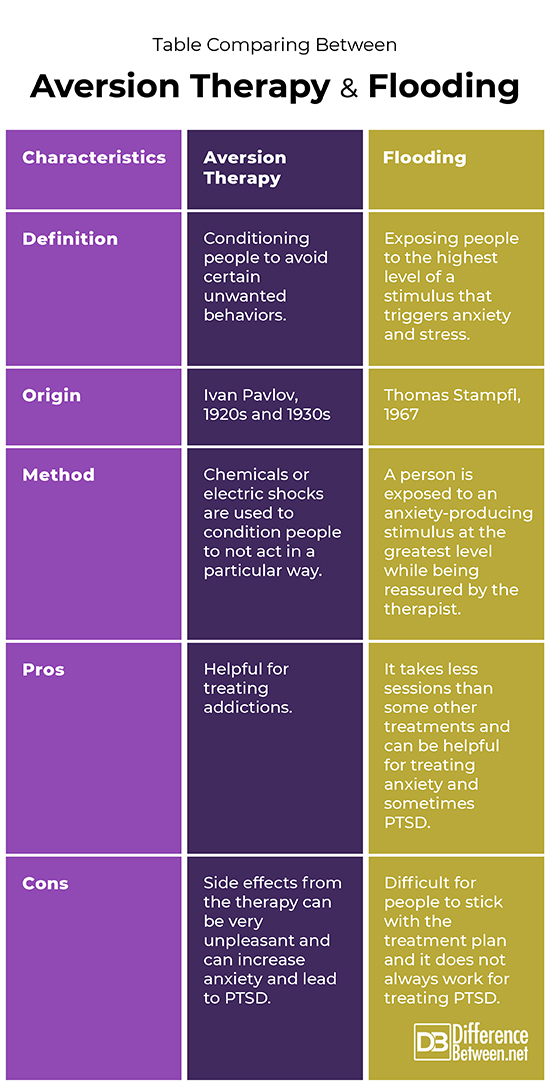Difference Between Aversion Therapy and Flooding
Aversion therapy is a technique used to get people to stop unwanted behavior. Flooding is when a person is exposed to the greatest level of a stimulus that they find unpleasant or anxiety-producing.

What is Aversion therapy?
Definition:
Aversion therapy is a treatment method to get people to stop a particular behavior through conditioning.
Method:
There are a few techniques that can be used in aversion therapy. For instance, a very mild electric shock can be given to the person every time they behave in a way that is undesirable. In other cases, chemicals that cause nausea can be used. An example of this is someone who is an alcoholic who gets sick every time they take a drink.
Advantages:
A big advantage of aversion therapy is to help people break addictions such as in cases of substance abuse. It has been used successfully to help people suffering from alcohol addiction.
Disadvantages:
A drawback of aversion therapy is the method can have unpleasant side effects. For instance, the vomiting from chemical aversion therapy can be physically harmful to the person. It can also actually lead to other psychological problems such as anxiety and PTSD.

What is Flooding?
Definition:
Flooding is a method in which an individual is exposed to the strongest intensity of whatever stimulus or object they are afraid of or have anxiety over.
Method:
The method is also known as in vivo exposure. The patient is exposed to the maximum level of whatever was causing them anxiety or stress. The therapist helps reassure the patient and may teach them relaxation methods prior to the flooding activity. The idea behind this therapy is for the patient to break the association of the event or stimulus with feeling anxiety and stress.
Advantages:
A big benefit of flooding is it takes less time than some other types of exposure therapy. It has been used to treat anxiety disorders and OCD. It is sometimes helpful for people who suffer from PTSD.
Disadvantages:
In some cases where PTSD is treated with flooding patients may have a relapse. Patients may also suffer worse depression. Flooding may not work as well for PTSD as for general anxiety problems.
Difference between Aversion therapy and Flooding
Definition
Aversion therapy is a method of conditioning people to avoid certain unwanted behaviors. Flooding is technique in which people are exposed to the highest intensity of a stimulus that causes them great anxiety.
Origin
Aversion therapy originated from the ideas of Ivan Pavlov in the 1920s and 1930s. Flooding originated in 1967 from Thomas Stampfl.
Method
Aversion therapy can be done by chemical means or by administering small electric shocks. Flooding is done by exposing the patient to an anxiety-producing stimulus at the greatest level while being reassured by the therapist.
Pros
The benefit of aversion therapy is that it is very useful and helpful for treating addictions. The benefits of flooding is that it takes less time to do and can help treat anxiety and PTSD.
Cons
A negative aspect of aversion therapy is that there can be very unpleasant side effects and a risk of triggering anxiety and PTSD. A drawback of flooding is that people have a hard time sticking to the treatment plan and it is not always useful for PTSD.
Table comparing between Aversion therapy and Flooding

Summary of difference between Aversion therapy and Flooding
- Aversion therapy helps by conditioning people to avoid unhealthy habits like addictions.
- Flooding is when people are exposed to panic-provoking stimuli in order to learn how to manage their emotions.
- There are benefits and drawbacks to both aversion therapy and flooding.
FAQ
What is the difference between flooding and systematic desensitization?
Flooding is when an individual is put in a position of experiencing an anxiety-producing event or object all at once. Systematic desensitization is when the person is slowly and over time, exposed to that which is causing them anxiety.
Is flooding or systematic desensitization more effective?
For certain phobias, such as those where a person is scared of reptiles, flooding has proven to be a better way to treat the patient but in other cases, systematic desensitization worked better for the same phobia. It is thought that systematic desensitization is more effective because people are more apt to stick with the treatment compared with flooding which may be too intense for some patients.
What is the flooding therapy technique?
The flooding therapy technique entails exposing a person to the highest level of a stimulus that gives them anxiety or PTSD and helping them overcome their behavioral response to said stimulus.
Is flooding a CBT technique?
Flooding is a technique used in cognitive behavioral therapy.
What is the definition of aversion therapy?
Aversion therapy is when a patient is conditioned to avoid certain harmful behaviors that they have engaged in.
Which type of psychotherapy uses aversion therapy?
Psychotherapy where the aim is to teach people to associate a negative consequence with an unwanted behavior, uses aversion therapy.
- Difference Between Rumination and Regurgitation - June 13, 2024
- Difference Between Pyelectasis and Hydronephrosis - June 4, 2024
- Difference Between Cellulitis and Erysipelas - June 1, 2024
Search DifferenceBetween.net :
Leave a Response
References :
[0]Cannon, Dale S., and Timothy B. Baker. "Emetic and electric shock alcohol aversion therapy: assessment of conditioning." Journal of Consulting and Clinical Psychology 49.1 (1981): 20.
[1]Jaeger, Jeff A., et al. "Factors associated with choice of exposure therapy for PTSD." International Journal of Behavioral Consultation and Therapy 5.3-4 (2009): 294.
[2]Pitman, Roger K., et al. "Psychiatric complications during flooding therapy for posttraumatic stress disorder." The Journal of clinical psychiatry (1991).
